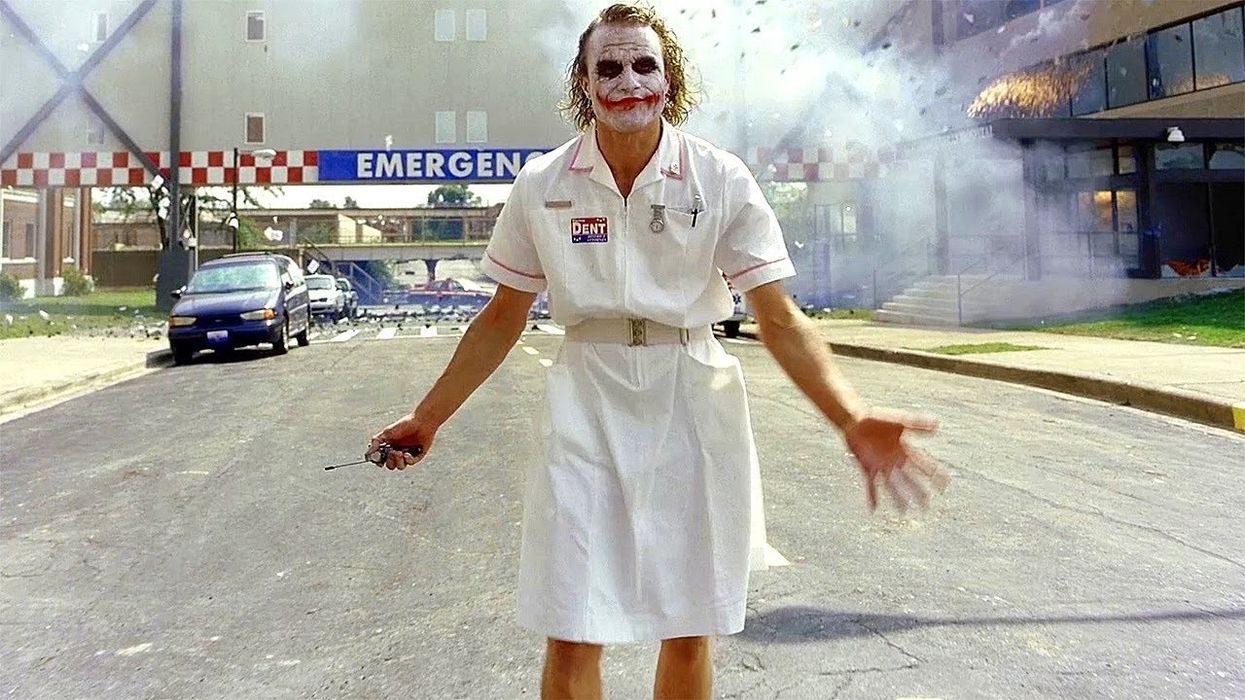What Does it Mean to 'Commit to the Bit'?
And why is this so important to writers and directors?

The Dark Knight
Like many people living in Los Angeles, I took an improv class when I was younger. I think it really helped me learn how to pitch and to feel comfortable with all the attention on me. But aside from that, it taught me the most important writing lesson of all time: Commit to the bit.
This sentiment was echoed to me when I became friends with some comedians the following year. They said it over and over when they were working out their new material.
To "commit to the bit" means to fully embrace and dedicate oneself to the execution of a creative idea, character, or scene, no matter how absurd or challenging it may seem, with unwavering conviction and sincerity.
Today, we're going to explore why that is so important for filmmakers.
What Does "Commit to the Bit" Mean?

Lincoln committing to the bit
Dreamworks/20th Century Fox
At its core, "Commit to the Bit" is about dedication to the joke or the idea. It's the process of taking a concept, no matter how wild, and giving it your all to bring it to life.
You have to fully dedicate yourself to it in order to preserve the context within the narrative you're creating.
What Happens If You Don't Commit to the Bit?

Breaking Bad
AMCIf you don't commit your audience will lose thier suspension of disbelief and the bit will fall flat.
In comedy, that means you won't get laughs. In acting, it means you won't have the authenticity of the characters. For writers, it can mean the idea will feel half-baked. And in directing, it means you're not buying fully into the genre.
Commit to your story and good things happen.
I love a movie or TV show that tries something and fails more than one that phones it in and succeeds. Take risks and good things happen.
If you have a weird idea or are playing in a new genre sandbox, don't half-ass it. Go all in.
When there's a full commitment, even the most bizarre or daring scenes can resonate profoundly with the audience, often becoming the most memorable moments of a piece.
Examples Of Committing to the Bit in Film and TV

Gravity
Warner Bros.
One of the things I love about this mantra is that it extends across different jobs within the film and TV community. I adopted it from improv people and comedians, but it can be applied to actors, directors, writers, and the lot.
So, let's look at how it works across positions.
1. Method Acting
One of the most renowned examples of committing to the bit is the method acting approach, where actors fully immerse themselves in their characters to deliver authentic and compelling performances.
- Daniel Day-Lewis in Lincoln (2012): Day-Lewis is famous for his method acting, and his portrayal of Abraham Lincoln is a prime example. He remained in character throughout the filming process, adopting Lincoln's mannerisms and voice, even off-camera, which contributed to a performance that won him his third Academy Award for Best Actor.
2. Auteur Directing
Directors often commit to their unique styles or storytelling techniques, creating distinctive and unforgettable cinema.
- Wes Anderson's Composition: Anderson's commitment to his distinctive visual style, characterized by symmetrical compositions, meticulous set designs, and a vibrant color palette, is evident in films like The Grand Budapest Hotel (2014). His unwavering dedication to this style has made his work instantly recognizable and critically acclaimed.
3. Physical Transformations for Roles
This probably could go under method acting, but we gave it attention here. Actors undergoing significant physical transformations to better embody their characters is a testament to their commitment to the bit.
- Christian Bale in The Machinist (2004): Bale's drastic weight loss to play the insomniac Trevor Reznik showcased an extreme level of dedication to his role, deeply affecting audiences with the physical manifestation of his character's psychological turmoil.
4. Immersive Worldbuilding
Directors and production teams that commit to creating immersive worlds allow audiences to fully engage with the narrative, often leading to iconic film and TV franchises.
- Peter Jackson's The Lord of the Rings Trilogy: Jackson's commitment to bringing J.R.R. Tolkien's world to life involved meticulous detail in set design, costumes, and special effects, creating a believable and immersive Middle-earth. This dedication paid off with multiple Academy Awards and a lasting legacy in film history.
5. Innovative Filmmaking Techniques
Embracing innovative techniques to tell stories in new and engaging ways showcases a commitment to pushing the boundaries of the medium.
- Alfonso Cuarón for Gravity (2013): Cuarón's use of groundbreaking visual effects and long, unbroken takes immersed viewers in the vastness and danger of space like never before. His commitment to this vision resulted in a visually stunning film that won seven Academy Awards, including Best Director.
In an industry that thrives on originality and impact, committing to the bit can be the difference between creating something good and creating something unforgettable.
Let me know what you think in the comments.
- Mixing Comedy, Action, and Personality in Sound for 'Thelma' ›
- 8 Great Filmmaking Lessons from 'Tropic Thunder' ›
- Andy Serkis Breaks Down a Scene from 'Venom: Let There Be Carnage' ›











